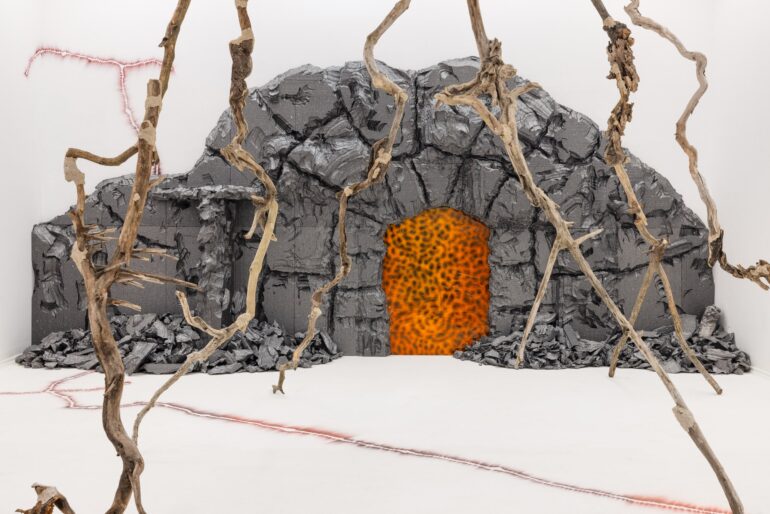

November 29, 2024
OPENING: Friday, 29.11.2024, at 6 p.m
29.11.2024 - 18.01.2025
curator: Katarzyna Krysiak
ABOUT THE EXHIBITION:
The "Calcium Carbonate" exhibition is a site-specific installation of an archaeo-geological nature, in which the geological past dialogues with the imagination of the future. It is an extension of the artist's previous interests.
The street or ‘squatter’ genealogy of Szumski’s work is evident not only on a stylistic level in his works, but also in the form of the connection between the paintings and the given space. The walls, floor and ceiling of the gallery will be covered with airbrush paintings that combine suggestions of archaeological excavation aesthetics and Neolithic symbolism with influences of street graffiti. These will be complemented by spatial forms that have been transformed using the latest technological solutions. Szumski does not just create a specific environment – he seeks new forms for hybrid sculptures, which he makes with plastics and ceramics as well as organic materials, including found animal bones (e.g. Szkieletron [Skelethrone] – a hybrid of a ‘human’ skeleton and a throne – presented at the Zachęta Gallery as part of the exhibition Niepokój przychodzi o zmierzchu [Disquiet Comes at Dusk]).
The titular calcium carbonate (CaCO₃) is an inorganic chemical compound that is widespread and long-lived in nature, and is an essential component of many minerals and some rocks, including, for example, stromalites formed billions of years ago, which are traces of cyanobacterial activity. Calcium and carbon are elements of great importance to living organisms, calcium being the basic building block of bones and some cell walls. Calcareous rock is used as building material and, when pulverized, as raw material for quicklime. Very finely ground calcium carbonate is also sometimes used as a white dye in the production of a simple water-based paint for whitewashing tree trunks and house walls. Stach Szumski looks at the ‘circulation’ of calcium carbonate in nature, an endlessly repeating cycle. ‘Grinding’ and cyclicity within a cultural framework are important themes in the exhibition.
By introducing the term osteomorphism, or the transformation of bone matter (osteo – bone), Szumski examines bone from the perspective of the course of evolution, how it morphed, changed its structure, shape, and dimensions, how it mineralized, compressed, only to dissolve again and become an organic-mineral form of cave dripstone. Here, bone becomes a carrier of information, from an archaeological, archaeo-biological perspective. In the exhibition, the motif of the transformation of bones and the morphing of their forms will be captured in the sculptures. The artist creates speculative entities, depicting bone formations that do not exist in reality, ‘grinding’ into each other. In this way, he shapes a completely new creation, a new unit whose structure alludes to bone architecture, Neolithic tools made from bones, a kind of bone processing practiced for utilitarian-survival purposes.
STACH SZUMSKI Stach Szumski, born in 1992, is a visual artist moving in the area from illegal street art to conceptual, intermedia institutional projects. He works in painting and creates installations, sculptures, prints, drawings, and interventions in public space. He graduated from the Faculty of Media Art at the Academy of Fine Arts in Warsaw, but he owes his painting education above all to grassroots practices associated with the exploration of Lower Silesian vacant houses and the opportunities offered by spray paint. His visual identity and research direction have been influenced by the Czech graffiti community and his love of natural history, particularly prehistoric pictographs and cave paintings. From 2013–2016, he co-founded the Warsaw Gallery V9. From 2015–2020, together with Karolina Mełnicka, he headed the Nomadic State project – an artist collective and a fictional, nomadic micro-state. In his works, he quotes and deconstructs iconographic motifs used in human communication since its origins: from prehistoric wall paintings, Neolithic petroglyphs or medieval symbols to contemporary graffiti and deconstructed logos. His works have been presented in numerous galleries in Poland and abroad, including CCA-Zamek Ujazdowski, MSN in Warsaw, National Museum in Wrocław, Kyoto Art Center, and Parcel Gallery in Tokyo. Both his large-format wall paintings and interdisciplinary projects, which he often bases on historical research, are realized during his many journeys around the world. He lives and works in Michałowice (Karkonosze).
Fot. Szymon Sokołowski